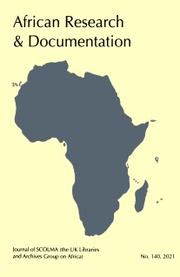No CrossRef data available.
Article contents
Arabic Documentation in Darfur
Published online by Cambridge University Press: 25 April 2022
Extract
One major obstacle to the study of Sudanese history before the Mahdist period (1885—1898) has been the seeming lack of any substantial documentation of local origin; nowhere was this more so than in Darfur. But it is now becoming apparent that, contrary to previous assumptions, Darfur and probably also Kordofan are very rich in Arabic documents, preserved as family archives, dating from the pre-Mahdist period.
As part of a continuing programme of research on the history of the Darfur Sultanate (c. 1650—1916), I recently visited Darfur on a trip financed by the Norwegian Research Council and sponsored by the Central Records Office (CRO), Khartoum, who kindly arranged for Sayyid Ahmad Ibrahim Uthman of the CRO to accompany me.
During a period of six weeks spent in the Al-Fashir region i.e. around the province capital, a total of over 200 documents from the Darfur Sultans and their officials, and some from Mahdist officials, were located and photographed.
- Type
- Documentation
- Information
- Copyright
- Copyright © International African Institute 1974
References
1 See J.-F. Fourcade, ‘Documents arabes interessant l'histoire du Dār-Fūr, Dossiers de la R.C.P. no 45, 1, 1968, 35—53, Centre National de la Recherche Scientifique, Paris.
2 Some of these have been published in R. S. O'Fahey & Abdel Ghaffar Muhammad Ahmad, ‘Documents from Dar Fur’, fascicles 1 & 2, occasional papers 1 & 2, 1972 & 1973, Programme for Middle Eastern and African Studies, University of Bergen. Copies are available from the Historisk Institutt, University of Bergen. Bergen 5000, Norway.


